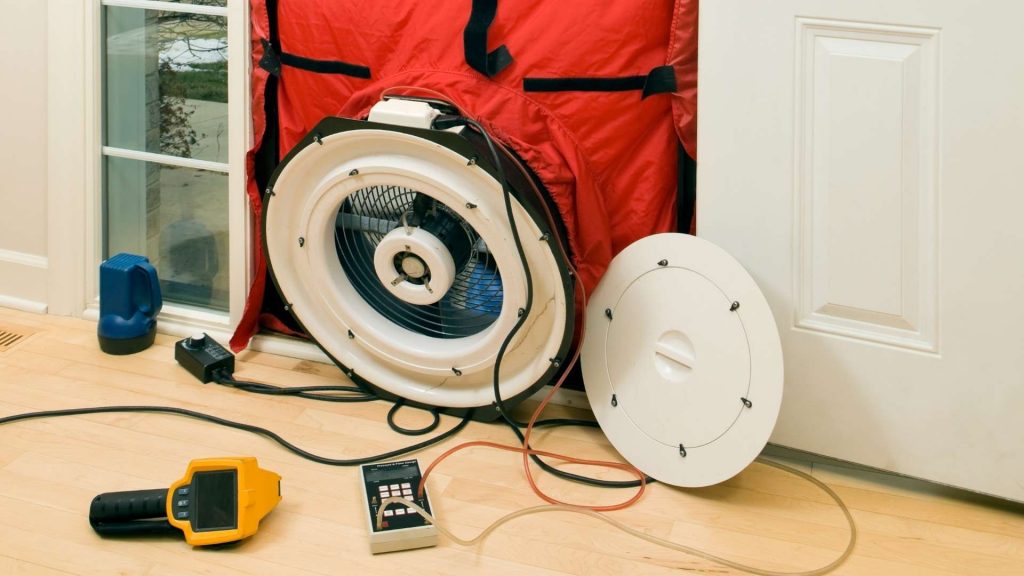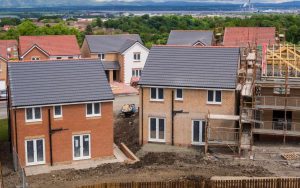Do I need an air test?
Before you can get an air test in Staffordshire, your dwelling must be completed. This means that walls, windows, skirting, lighting, switches, and doors are all in place. This is so that the air tester can get a good idea of how much air is getting into the building. The air tester will use blower door testing equipment – which are basically big fans – to pressurise and depressurise the building. The tester will then use an anemometer to measure the difference in pressure inside and outside the building. This is to ensure that you do not have any leaks or other air tightness problems.
Why is Air Testing Important?
Air permeability testing is an important aspect of building design. It ensures that a building is airtight, which is important for energy efficiency. Poorly sealed buildings can lose heat and cold air, making them less comfortable to live in. Furthermore, air testing reduces the energy bill of a building and helps it to be environmentally friendly.
According to current building regulations, a building should have an air leakage rate of 5m3/hm2 or less. This measurement is based on the ‘design air permeability’ value, which is set during the design stage of a building. Air tightness legislation was introduced by the UK government to ensure that buildings met minimum standards. The legislation also aims to ensure that the materials and workmanship of buildings are up to scratch.
How is an Air Test Performed?
 When it comes to the performance of a building envelope, an air permeability test is essential to ensure that the air leakage rate does not exceed the allowed maximum allowed by building regulations.
When it comes to the performance of a building envelope, an air permeability test is essential to ensure that the air leakage rate does not exceed the allowed maximum allowed by building regulations.
This is calculated as the air leakage rate per square metre of envelope area per hour. This figure may differ slightly depending on the sample used.
Nonetheless, it is often regarded as the headline result of the test, and it tells us how much air is escaping from the building when a fan is running at 50 Pascals.
The test is carried out using a device that is placed in the building envelope. The device then uses a fan to depressurise the building. This device records the difference between the external and internal pressure to determine the permeability of the envelope.
This test is important to ensure that a building is energy efficient, as air leaking from an envelope can lead to poor energy efficiency and cold draughts. The main advantage of air testing is that it can help build a more environmentally friendly building, while also lowering the cost of energy bills.
Air Tightness Testing for New Builds
Air Tightness Testing for new builds is an important step in the building process. This process measures the amount of air that can escape from a building and ensures that it is as energy efficient as possible. The building envelope is depressurised and a specialist fan is used to measure the amount of air that can leak through. Having this checked is required under government regulations so that new builds are energy efficient.
It costs hundreds of pounds to keep heat in a house, and heat loss can total thousands of pounds. As well as saving money on energy bills, airtightness testing also helps to prevent the spread of fire. Fires spread much faster if air cannot flow in a building, which can result in severe damages. By following the advice of an Air Tightness testing specialist, you will ensure that the building you are building will be safe from the elements and will be energy efficient.
Commercial Air Testing
If you’re looking to save money on energy bills and improve the energy efficiency of your commercial building, you need to consider commercial air permeability testing. This type of test ensures that the Design Emission Rate of your building is lower than the Target Emission Rate. The government has made commitments to reduce the carbon emissions of buildings to protect our planet. The European Energy Performance of Buildings Directive (EPBD) and the Kyoto Agreement have set out guidelines for the conservation of fuel and power in buildings. These regulations also require commercial buildings to pass the Commercial Air Pressure Test.

The test is conducted by measuring the pressure differential in the air entering and exiting a building. The readings are recorded at different speeds and are then corrected for barometric pressure and temperature. During an air permeability test, access into or out of the building is not permitted, so ventilation systems, kitchen hoods, and exhaust fans must be sealed. Drainage traps should also be prepared.
SAP Calculations in Staffordshire
Do I need SAP Calculations? Do I need them for my Extension? This article will help you decide if you need to carry out SAP Calculations in your Staffordshire property. You will also find out whether you need them for a New Build or an Extension. By reading this article, you will be able to make an informed decision about whether you need these calculations for your building project.
What are SAP Calculations?
SAP Calculations show how energy efficient a development is before it is built, which is essential for modern buildings. They also help you to understand how much energy you will use to run your property. SAP Calculations are typically required for new builds, but they can also be used in home extensions and conversions.
SAP Calculations are essential to comply with Building Regulations in England and Wales. They help to ensure the design of new homes is energy efficient and meets the latest building regulations. They are also necessary for converting existing properties and extensions, which can be tricky for first time builders. They can also help you achieve green targets and help you meet your local recycling policy.
SAP is an acronym for Standard Assessment Procedure, which is a government method of calculating energy efficiency in dwellings. SAP Calculations take into account the energy use and energy retention of a property, and give you an overall score between 1 and 100. A higher score means lower running costs.
Do I need SAP Calculations?
If you’re considering building a new home or renovation project, you may be asking yourself: “Do I need SAP Calculations in Staffordshire?” These calculations measure the amount of energy that’s lost through the walls and floors of a building and determine whether or not it’s compliant with Building Regulations.
They are required for new buildings, pre-built dwellings, and buildings that change from two to more units. They also determine whether the home or building meets the required levels of air conditioning and heating and are compatible with renewable technologies.
Once the calculations are complete, the assessor will produce a report for the client and designer. The report contains a score that measures the energy performance of a dwelling based on the design that was agreed. The assessment will also include an Air Pressure Test (which must be carried out on most newly constructed dwellings), which the client will supply to the assessor.
If there are any variations to the specification, the client will need to inform the assessor so that the finalised design meets the SAP requirements.
SAP calculations for Extensions
Whether you’re planning on building an extension or converting an existing property, you will need to undergo SAP calculations. These calculations are essential in order to comply with current Building Regulations and ensure your extension is energy efficient.
The calculation takes a number of factors into account, including the type of dwelling, the type of windows and doors, and other energy-related elements. Once completed, the calculations are compared to the TER (the target emission rate) for a particular building type.
The calculation will include both the current house and the proposed extension. This will ensure that the proposed build is energy efficient and that CO2 levels are within the set tolerances. You can improve these calculations by making small adjustments to the construction, such as adding extra loft insulation or installing glass with a high solar gain. Another option is to replace an old boiler with a more energy-efficient one.
SAP calculations for New Builds
Whether you’re planning a new build, extension, or renovation, you need to perform SAP calculations to ensure that your property meets minimum regulations for energy efficiency. These calculations involve a desktop exercise, rather than a site survey, and include several important elements, including the site plan, floor plans for each storey, and a written specification.
This specification should include information about the main heating and secondary heating systems, as well as internal lighting.
SAP calculations are a required part of the Building Regulations for new dwellings. They are detailed projections of energy consumption and emissions. Accredited assessors perform these calculations on new builds in Staffordshire, and can produce the reports you need within five days.
SAP Calculations EPC
SAP Calculations are important if you intend to convert a dwelling from one use to another. These calculations will show the energy efficiency of the building fabric and emission rates. For this purpose, a good set of building drawings is essential. The assessor will then advise you on what you need to do in order to comply with the regulations.
SAP Calculations are required by the Building Regulations in the UK, and they can prove whether a building meets its energy targets. As well as demonstrating a building’s energy efficiency, SAP Calculations can be used to help determine whether it’s affordable to run and maintain.
Areas in and around Staffordshire we service include:
Alton | Audley | Barton-under-Needwood | Biddulph | Burntwood | Burton upon Trent | Cannock | Cheadle | Codsall | Eccleshall | Essington | Hanley | Hednesford | Hixon | Kidsgrove | Leek | Lichfield | Madeley | Newcastle-under-Lyme | Penkridge | Rugeley | Shenstone | Stafford | Stoke-on-Trent | Stone | Tamworth | Tutbury | Uttoxeter | Wheaton Aston | Wombourne





